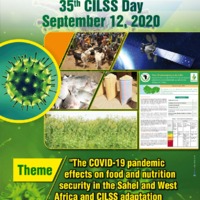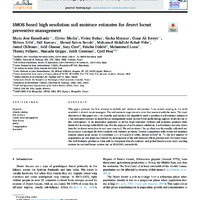Recherche
4 items
35th CILSS Day September 12, 2020
"The COVID-19 pandemic effects on food and nutrition security in the sahel and west Africa and CILSS adaptation efforts for information production"
Forum 2024 2024 Forum on Seasonal Forecasts of Agro-hydro-climatic characteristics of the rainy season for Sudanian and Sahelian zones of West Africa (PRESASS, 2024)
A generally wet 2024 rainy season is expected over the Sahelian strip, with late to average onset dates in the Central Sahel and early to average in the Western and Eastern Sahel, late to average cessationdates, short dry spells at the beginning of the season in the Western Sahel and average to long dry spells in the Eastern Sahel and overall long towards the end of the season across the entire strip Sahelian region, and overall above-average flows in the main river basins of the Sahel.
Regional report on food and nutrition security for West Africa and the Sahel 2024 | In brief
The result of a partnership between the Permanent Interstate Committee for Drought Control in the Sahel (CILSS) and the Food Security Information Network (FSIN), this report on food security and nutrition in West Africa and the Sahel provides timely and reliable data needed to address growing food security and nutrition challenges in the region. The food and nutritional situation is worrying for the 2024 lean season. Even
though the number of people in the highest phases has significantly decreased in several countries since the 2023 peak, the aggregate number and percentage of people in CH Phase 3 or above are projected to be the highest ever recorded in CH history due to the interaction between conflict and civil insecurity, economic shocks, weather extremes, underlying
poverty, and other vulnerability factors.
SMOS based high resolution soil moisture estimates for desert locust preventive management
This paper presents the first attempt to include soil moisture information from remote sensing in the tools available to desert locust managers. The soil moisture requirements were first assessed with the users. The main objectives of this paper are: i) to describe and validate the algorithms used to produce a soil moisture dataset at 1 km resolution relevant to desert locust management based on DisPATCh methodology applied to SMOS and ii) the development of an innovative approach to derive high-resolution (100 m) soil moisture products from Sentinel-1 in synergy with SMOS data. For the purpose of soil moisture validation, 4 soil moisture stations where installed in desert areas (one in each user country). The soil moisture 1 km product was thoroughly validated and its accuracy is amongst the best available soil moisture products. Current comparison with in-situ soil moisture stations shows good values of correlation (R > 0.7) and low RMSE (below 0.04m3 m−3). The low number of acquisitions on wet dates has limited the development of the soil moisture 100m product over the Users Areas. The Soil Moisture product at 1 km will be integrated into the national and global Desert Locust early warning systems in national locust centres and at DLIS-FAO, respectively.


